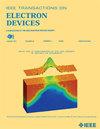Dopant-Assisted Exciton Enhancement: Improved Photoelectric Performance in Copolymer-Based Photodiodes
IF 2.9
2区 工程技术
Q2 ENGINEERING, ELECTRICAL & ELECTRONIC
引用次数: 0
Abstract
Copolymers organic semiconductors (OSCs) such as diketo pyrrolopyrrole-thieno[3,2-b]thiophene (DPPT-TT) have demonstrated strong peak absorption in ultraviolet (UV) and near-infrared (NIR) regions. However, OSC-based photodiodes (OPDs) still suffer from low photodetection efficiency and photocurrent due to the high recombination rate of Frenkel excitons and limited light absorption caused by the thin active layer. In this work, a dopant-assisted exciton enhancement (DEE) mechanism is explored. By introducing a dopant layer between the bottom electrode and active layer, charge transfer is driven, significantly suppressing exciton recombination, resulting in more than a ten-fold increase in photodiode responsivity. To further enhance light absorption, a layer of metal particle nanostructure is employed. The fabricated OPDs exhibit significantly improved photoelectric performance, achieving a photocurrent density of 15.83 mA/cm2 under a light intensity of 0.002 W/cm2 at 264 nm. The external quantum efficiency (EQE) reaches approximately 98.41% at a bias voltage of 2 V, which is a 27-fold increase compared to conventional devices. Experimental results demonstrate that thin organic photodetectors, modified by electrophilic substitution and light scattering principles, hold great potential for nonvisible light band detection.求助全文
约1分钟内获得全文
求助全文
来源期刊

IEEE Transactions on Electron Devices
工程技术-工程:电子与电气
CiteScore
5.80
自引率
16.10%
发文量
937
审稿时长
3.8 months
期刊介绍:
IEEE Transactions on Electron Devices publishes original and significant contributions relating to the theory, modeling, design, performance and reliability of electron and ion integrated circuit devices and interconnects, involving insulators, metals, organic materials, micro-plasmas, semiconductors, quantum-effect structures, vacuum devices, and emerging materials with applications in bioelectronics, biomedical electronics, computation, communications, displays, microelectromechanics, imaging, micro-actuators, nanoelectronics, optoelectronics, photovoltaics, power ICs and micro-sensors. Tutorial and review papers on these subjects are also published and occasional special issues appear to present a collection of papers which treat particular areas in more depth and breadth.
 求助内容:
求助内容: 应助结果提醒方式:
应助结果提醒方式:


